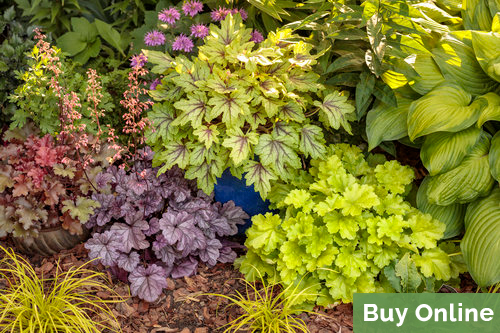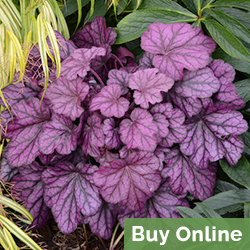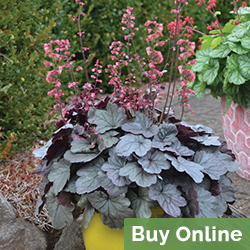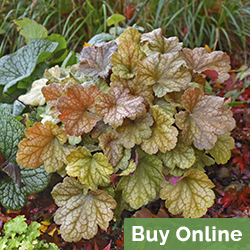Heuchera - The Ultimate Guide to Coral Bells from Proven Winners®
Heuchera is a versatile perennial, with attractive foliage and bell-shaped flowers. Also known as coral bells, they offer an array of colors and forms, multi-seasonal interest and long bloom time. Grow them in a shade garden or in pots.
Buy heuchera plants - Browse 22 types of heuchera and have them shipped right to your door
PLANTING & CARING FOR CORAL BELLS
One of the easiest perennials to grow, coral bells are virtually carefree. Here are the basics:
- Hardy in USDA zones 4-9, coral bells are tolerant of a wide range of light conditions, poor soil, heat, cold, humidity and drought.
- Foliage comes in nearly every color imaginable, from silver to nearly black. Leaves are patterned, ruffled, wavy or smooth.
- Flowers occur in hues of coral, red, white or pink and are attractive to butterflies and hummingbirds, and are long-lasting in cut arrangements.
How to plant: Plant coral bells in spring or fall. Space plants 1-2 feet apart.
Light: Coral bells can be grown in a wide range of light conditions, from full sun to shade. Foliage color and bloom are best when plants receive at least 4-6 hours of direct sunlight.
Soil: Heuchera does best in rich well-draining soil, but is tolerant of clay or rocky soils and salt. If you have heavy clay garden soil, amend it to improve the drainage before planting your new coral bells or plant them in a raised bed.
Watering: Keep soil evenly moist but not soggy. Heuchera is somewhat drought-tolerant once established. Provide extra water during hot spells.
Fertilizing: In spring, spread a thin layer of compost or apply a balanced slow-release granular fertilizer around the base. For container-grown plants, supplement with a water-soluble fertilizer according to instructions.
Pruning: Trim back tattered foliage in early spring.
Pots: Coral bells grow beautifully in containers. Just make sure there is a hole in the bottom where the excess water can drain from. Transplant into the landscape in early fall if you'd like them to come back again next year. If you garden in zones 6b or warmer, they can be overwintered in containers.
VARIETIES OF CORAL BELLS
Proven Winners® coral bells come in a wide range of foliage colors, patterns and shapes. Try these in your garden:
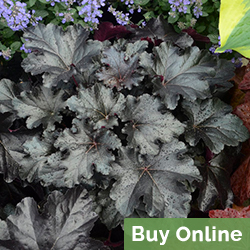 Primo® ‘Black Pearl’ is similar to ‘Obsidian’, but with darker purple-black coloring. Ruffled leaves set off dainty flowers with pink buds that open to snow-white. Makes a sophisticated accent in a pot, or at the front of a sunny border. |
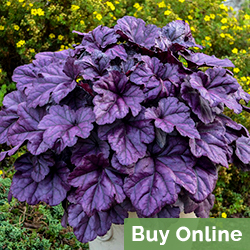 Dolce® ‘Wildberry’ looks similar to ‘Forever Purple’, but holds its intense purple coloring better throughout the growing season. Use as a container accent or mass in a sunny border for a bright splash of color. |
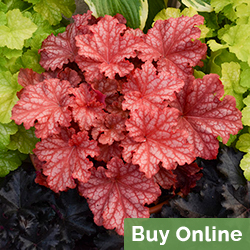 Primo® ‘Peachberry Ice’ has striking ruffled apricot-orange leaves with pink undersides. Bright new growth mellows in summer to complement the cream flowers. Use this low spreader as a groundcover to illuminate shady woodland borders. |
Primo® ‘Wild Rose’ sports rose-red flowers and rich purple-red leaves with charcoal-gray veining. Place alongside gold-foliaged plants to lend striking contrast in a mixed border. |
Dolce® ‘Silver Gumdrop’ has semi-glossy silver veined leaves that develop a rosy blush overtone later in the season. Vibrant pink flowers that bloom in mid-summer stand out against the elegant foliage. Use to brighten up a shady border. |
Dolce® ‘Toffee Tart’ has rich amber new growth that fades to ginger to complement the creamy white flowers. Similar to ‘Caramel’, it’s more fade- and burn-resistant. The diminutive size is suitable for container combinations or pathway edging. |
Tips for picking the right heuchera for your garden:
Primo® coral bells are larger and make showy specimens in containers, and pair easily with hostas and other part shade loving plants in the landscape. Primo varieties are well-suited to climates with hot, humid summers but thrive all across North America.
Dolce® coral bells tend to be smaller plants than those in the Primo collection. That makes them easier to pair with other plants in container recipes and to use near the front of the landscape border.
Varieties with lighter colored leaves, like yellow or soft peach, need more shade to protect them from sun scorch. Plant them in morning sun or full shade.
Varieties with near-black foliage or another saturated color can handle more sun. In cooler growing regions, they will even grow in full sun if given enough moisture.
Coral bells with especially fuzzy leaves tend to prefer less water and be more heat tolerant than those with shiny leaves. Those are good choices to plant in warmer climates and in places where the soil tends to be a bit drier.
Some varieties of coral bells change colors throughout the year. Spring and fall weather tends to make the colors brighter while the summer’s heat may encourage a light silvering to develop on some varieties. This is perfectly normal and should not be a cause for concern.
Some varieties of coral bells produce showy flowers while others are grown strictly for their foliage. When shopping, read the plant label to know whether you should expect showy blooms to appear.
Varieties that produce flowers can be used as cut flowers in fresh bouquets. The flower stems are typically long and strong enough for cutting and the flowers last several days. The leaves of coral bells can also be used in small arrangements.
Bees, butterflies and hummingbirds are attracted to coral bells with vibrant red or pink flowers.
HOW TO USE CORAL BELLS IN YOUR LANDSCAPE
Coral bells can be used in many ways. Here are a few ideas:
- Place in groups of 3 or 5 at the front of a mixed border next to other complementary colored plants
- Mass as a low-maintenance groundcover along a slope
- Plant alongside a pathway
- Choose a variety that matches your house, patio furniture or other key landscape component for repetitive color
- Lighten up shady areas with brightly colored varieties such as Dolce® ‘Appletini’ or Primo® ‘Peachberry Ice’
- Plant in a rock garden in combination with alpines and succulents
- Naturalize in a woodland setting with natives and other shade lovers
- Plant in a smaller container as a stand-alone accent
- Combine in a container with other perennials or annuals
WHAT TO PLANT WITH HEUCHERA
Heuchera goes well with many other perennials, trees and shrubs. Here are some suggestions for companion plants:
For shady locations, combine with other woodland plants such as astilbe, bleeding heart, ferns, hellebores, hosta, Japanese forest grass and lamium.
For sunny sites, plant alongside artemisia, bugleweed, daylilies, geranium, iris, lady’s mantle, lysimachia and ornamental grasses.
HEUCHERA FAQ’s
Do heucheras die back in winter?
Coral bells are evergreen in warmer regions and semi-evergreen in colder climates.
Should you cut back heuchera?
If foliage looks ragged, cut plants back in early spring to stimulate fresh new growth. Remove any dead or damaged foliage as needed. Cut back spent flower stalks to encourage rebloom.
Are heucheras perennials?
Heucheras are reliable perennials in most regions.
What is the best place to plant coral bells?
Heucheras are native to North American woodlands, prairies and mountain regions. They will thrive in conditions that simulate their native habitat.
How much water do they need?
Coral bells prefer moist, well-drained soil. Soggy, wet soil, especially over the winter months, kills more coral bells than cold temperatures. Don't plant them where you pile your snow for the winter.
Can coral bells be planted in full sun?
The ideal conditions for coral bells is part shade, meaning 4 to 6 hours of direct sunlight per day, and out of the way of scorching afternoon sun. However, heuchera plants will grow in any amount of sunlight, including full sun, as long as you water well. If the foliage starts to turn brown with crispy edges, it is probably getting too much sun and should be moved to a shadier location.
How big do heucheras get?
Coral bells have a mounding habit, growing 6-16 inches tall and 12-36 inches wide. Flower spikes reach 1-3 feet tall.



